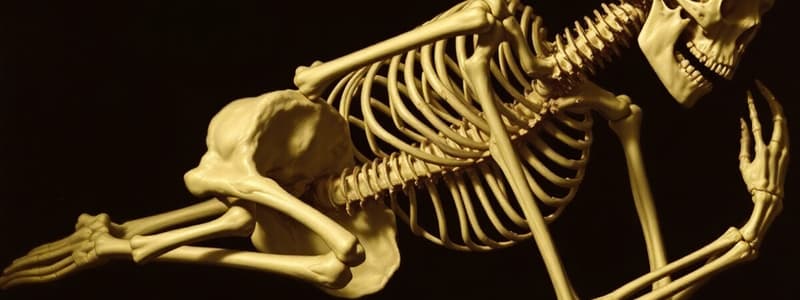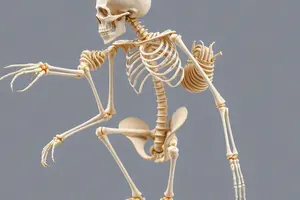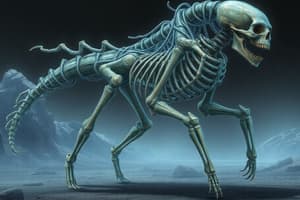Podcast
Questions and Answers
What is a defining characteristic of elastic cartilage?
What is a defining characteristic of elastic cartilage?
- It is found only in the joints.
- It is highly bendable. (correct)
- It contains primarily collagen fibers.
- It has a rigid structure.
Which of the following locations is NOT associated with elastic cartilage?
Which of the following locations is NOT associated with elastic cartilage?
- Larynx
- Epiglottis
- Outer ear
- Nose (correct)
What is the primary difference between elastic cartilage and hyaline cartilage?
What is the primary difference between elastic cartilage and hyaline cartilage?
- Elastic cartilage contains more elastic fibers. (correct)
- Hyaline cartilage is more flexible.
- Hyaline cartilage is found in the outer ear.
- Elastic cartilage has fewer fibers.
What type of fibers predominates in the matrix of elastic cartilage?
What type of fibers predominates in the matrix of elastic cartilage?
Which feature is important for the function of elastic cartilage in the epiglottis?
Which feature is important for the function of elastic cartilage in the epiglottis?
What are the components of the pelvic girdle?
What are the components of the pelvic girdle?
Which bone is recognized as the largest bone in the human body?
Which bone is recognized as the largest bone in the human body?
Which bone connects the pectoral girdle to the sternum?
Which bone connects the pectoral girdle to the sternum?
Which structure is NOT part of the pelvic girdle?
Which structure is NOT part of the pelvic girdle?
How many large, heavy hip bones make up the pelvic girdle?
How many large, heavy hip bones make up the pelvic girdle?
Where does the humerus fit in relation to the pectoral girdle?
Where does the humerus fit in relation to the pectoral girdle?
What is the correct term for the single bone structure that forms the base of the vertebral column and is part of the pelvic girdle?
What is the correct term for the single bone structure that forms the base of the vertebral column and is part of the pelvic girdle?
What is the primary function of the scapula?
What is the primary function of the scapula?
How does the arrangement of the pectoral girdle affect shoulder stability?
How does the arrangement of the pectoral girdle affect shoulder stability?
Which statement is true regarding the ligaments of the pectoral girdle?
Which statement is true regarding the ligaments of the pectoral girdle?
What connects the Humerus to the Radius and Ulna?
What connects the Humerus to the Radius and Ulna?
How many carpal bones make up the wrist?
How many carpal bones make up the wrist?
Which of the following groups of bones is NOT part of the hand?
Which of the following groups of bones is NOT part of the hand?
How many total Phalanges are there in both hands?
How many total Phalanges are there in both hands?
What is the correct order of the bones from proximal to distal in the forearm?
What is the correct order of the bones from proximal to distal in the forearm?
What type of joint is characterized as immovable and consists of bones that are sutured together?
What type of joint is characterized as immovable and consists of bones that are sutured together?
Which of the following examples correctly illustrates a cartilaginous joint?
Which of the following examples correctly illustrates a cartilaginous joint?
What is the primary function of fibrous joints?
What is the primary function of fibrous joints?
Which of the following options is NOT an example of a cartilaginous joint?
Which of the following options is NOT an example of a cartilaginous joint?
What type of joint connects bones using cartilage and allows slight movement?
What type of joint connects bones using cartilage and allows slight movement?
What type of joints are considered freely movable and include examples such as the knee and elbow?
What type of joints are considered freely movable and include examples such as the knee and elbow?
Which type of joint allows little to no movement?
Which type of joint allows little to no movement?
Which of the following statements best describes synovial joints?
Which of the following statements best describes synovial joints?
In the context of joint classification, which type specifically includes the knee and elbow?
In the context of joint classification, which type specifically includes the knee and elbow?
Which type of joint is characterized by cartilage connection and limited movement?
Which type of joint is characterized by cartilage connection and limited movement?
Flashcards
Elastic Cartilage
Elastic Cartilage
A type of cartilage with more elastic fibers than collagen fibers, making it highly bendable.
Elastic Fibers
Elastic Fibers
Strong, stretchy fibers in elastic cartilage that allow it to bend and return to its original shape.
Collagen Fibers
Collagen Fibers
Strong, supportive fibers in connective tissues, including cartilage.
Epiglottis Location
Epiglottis Location
Signup and view all the flashcards
Outer Ear
Outer Ear
Signup and view all the flashcards
Pectoral Girdle
Pectoral Girdle
Signup and view all the flashcards
Clavicle
Clavicle
Signup and view all the flashcards
Scapula
Scapula
Signup and view all the flashcards
Humerus
Humerus
Signup and view all the flashcards
Shoulder Joint Stability
Shoulder Joint Stability
Signup and view all the flashcards
Humerus, Radius, Ulna
Humerus, Radius, Ulna
Signup and view all the flashcards
Carpals
Carpals
Signup and view all the flashcards
Metacarpals
Metacarpals
Signup and view all the flashcards
Phalanges
Phalanges
Signup and view all the flashcards
Pelvic Girdle bones
Pelvic Girdle bones
Signup and view all the flashcards
Innominate bone
Innominate bone
Signup and view all the flashcards
Femur
Femur
Signup and view all the flashcards
Hip Bones
Hip Bones
Signup and view all the flashcards
Fibrous Joints
Fibrous Joints
Signup and view all the flashcards
Cartilaginous Joints
Cartilaginous Joints
Signup and view all the flashcards
Synovial Joints
Synovial Joints
Signup and view all the flashcards
Movable Joints
Movable Joints
Signup and view all the flashcards
Immovable Joints
Immovable Joints
Signup and view all the flashcards
Cartilaginous Joints
Cartilaginous Joints
Signup and view all the flashcards
Study Notes
Skeletal System Overview
- The skeletal system provides support, movement, and protection of internal organs.
- Three main types of skeletons exist: hydrostatic, exoskeleton, and endoskeleton.
Hydrostatic Skeleton
- Composed of fluid held under pressure within a closed body compartment.
- Cushions body parts from shock.
- Provides body shape that can change through muscle contractions.
- Offers support for muscle action.
- Found in earthworms, hydras, and jellies.
Exoskeleton
- A rigid external skeleton (hard or leathery).
- Arthropods have exoskeletons made of chitin.
- Mollusks have exoskeletons of calcium carbonate (shells).
Endoskeleton
- Internal skeleton made of hard or leathery supporting elements among soft tissues.
- Echinoderms (sea urchins, sea stars) have endoskeletons made of hard plates under their skin.
- Vertebrates have endoskeletons made of cartilage or a combination of cartilage and bone.
Vertebrate Endoskeleton - Cartilage
- Cartilage is made up of chondrocytes (cartilage-producing cells).
- Extracellular matrix is abundant, composed of collagen and elastin fibers.
- Jelly-like ground substance with complex sugars.
- Contains 60-80% water, contributing to its resilience.
- Lacks nerves and blood vessels.
Types of Cartilage
- Hyaline cartilage: Flexible and resilient, found in the ends of long bones, trachea, nose, and larynx.
- Elastic cartilage: Highly bendable, with more elastic fibers than collagen, found in the epiglottis and outer ear.
- Fibrocartilage: Resists compression and tension, with thick collagen fibers alternating with chondrocytes, found in intervertebral discs.
Vertebrate Endoskeleton - Bone
- Bones consist of 25% water, 25% protein fibers, and 50% mineral salts.
- Functions: growth, support, protection, movement, mineral storage (calcium and phosphorus), blood cell production (hemopoiesis in red bone marrow), and energy storage (adipose tissue in yellow bone marrow).
- Bone cells: osteoblasts (form new bone), osteocytes (maintain bone structure), osteoclasts (dissolve bone).
Long Bones
- Found in limbs, composed of a diaphysis (shaft), and epiphyses (ends).
- Dense tissue (compact bone) surrounds a hollow central canal filled with yellow marrow (stores fat).
- Spongy bone (at the ends) contains red marrow (produces blood cells).
- Joints are where two bones meet.
Compact Bone
- Osteocytes are in contact with blood vessels in Haversian canals (nutrients/waste).
- Haversian canals and the surrounding bone rings form the Haversian system/Osteon.
Spongy (Cancellous) Bone
- Found at the ends of long bones (epiphysis) and surrounded by compact bone.
- Composed of branching bony plates with spaces filled with red marrow.
Axial Skeleton
- Consists of skull, backbone (vertebrae), and ribs/ribcage
- Supports the trunk of the body.
- Vertebrae (cervical, thoracic, lumbar, sacrum, coccyx). Each vertebrae is part of a curve in the spine, offering support and flexibility.
- Rib cage protects vital organs.
Vertebrae
- 26 vertebrae form the vertebral column, a dorsal backbone that protects the spinal cord.
- Disks between vertebrae act as padding and shock absorbers, allowing for movement.
- The vertebral column serves as the anchor to all other bones.
Ribs and Sternum
- Ribs attach (directly or indirectly) to the thoracic vertebrae in the back and the sternum (breast bone) in front.
- Lower ribs (floating ribs) are not attached to the sternum.
- Ribs are numbered according to their attachment to the vertebral column and sternum.
Appendicular Skeleton
- Consists of bones in the pectoral and pelvic girdles and the limbs attached to them.
- (126 total bones)
- Pectoral girdle (shoulder) with arms and hands are specialized for flexibility.
- Pelvic girdle (hip) with legs and feet specialized for stability.
Pectoral Girdle and Appendages (Arm and Hand)
- Clavicle (collarbone) connects to the sternum.
- Scapula (shoulder blade) in the upper back.
- Humerus (upper arm), Radius and Ulna (forearm), Carpals (wrist), Metacarpals (hand), Phalanges (fingers).
- Parts loosely linked by ligaments (to give flexibility).
Pelvis and Appendages (Leg and Foot)
- Pelvic girdle consists of 2 large hip bones (innominate, ilium, ischium, pubis) and sacrum.
- Appendages: Femur (thigh), Tibia and Fibula (shin bones), Tarsals (ankle), Metatarsals (foot), Phalanges (toes).
Types of Joints
- Fibrous joints: Immovable, such as sutures in the cranium.
- Cartilaginous joints: Slightly movable, such as intervertebral discs and ribs/sternum.
- Synovial joints: Freely movable, such as in the knee and elbow. They contain synovial fluid and articular cartilage to reduce friction.
Studying That Suits You
Use AI to generate personalized quizzes and flashcards to suit your learning preferences.




